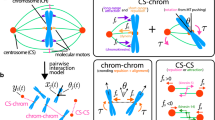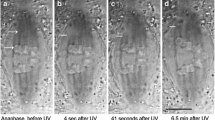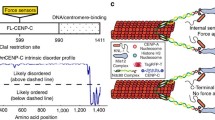Abstract
Living crane fly spermatocytes were irradiated in various areas, and changes in chromosome movement and changes in spindle fiber birefringence were measured.
The traction system was localized in the chromosomal spindle fibers; an undamaged traction fiber extending at least 1/2 the fiber length (from the chromosome) is necessary for normal movement. The results suggest, however, that the birefringent fiber is separate from the traction fiber, and therefore that the chromosomal spindle fiber is composed of at least 2 components. Otherwise, the following results characterize the traction fiber: birefringence is not necessary for movement, birefringence and movement are affected independently, the birefringent fiber moves poleward when the associated chromosome does not move, and the birefringent fiber moves poleward at a rate not related to that of the associated chromosome. These and other results are more easily explained under the assumptions: (1) during anaphase, the birefringent fiber is independent of the traction fiber, and (2) prior to anaphase, the birefringent fiber is not independent of the traction fiber.
The traction system was further characterized as follows: the anaphase movements of sister dyads are interdependent; in a cell, different sister dyad pairs are independent during anaphase but are not independent prior to anaphase; the initial separation of dyads is autonomous; the spindle organization changes markedly between metaphase and anaphase; and, something in the interzonal region is necessary for the subsequent division.
It was suggested that the interdependent movement of sister dyads is mediated via functioning kinetochores. It was further suggested that this interdependence is mediated via kinetochore-interzonal region interactions, and that the interzonal region is involved with regulating the amount of force on the chromosome.
Similar content being viewed by others
References
Ankel, W. E.: In: Mitogenesis (H. S. Ducoff and C. F. Ehret, edits.), p. 19. Chicago: Chicago University Press 1959.
Bäckström, H. L. J.: A filter method for the evaluation of ultraviolet radiation used in medicine. Acta radiol. (Stockh.) 21, 327–334 (1940).
Bajer, A.: Observations on dicentrics in living cells. Chromosoma (Berl.) 14, 18–30 (1963).
, J. Molé-Bajer: UV microbeam irradiation of chromosomes during mitosis in endosperm. Exp. Cell Res. 25, 251–267 (1961); - Cine analysis of some aspects of mitosis in endosperm. In: Cinemicrography in cell biology. (G. G. Rose, edit.), p. 357–410. New York: Academic Press 1963.
Bauer, H.: Die Chromosomen von Tipula paludosa Meig. in Eibildung und Spermatogenese. Z. Zellforsch. 14, 138–193 (1931).
, R. Dietz u. C. Röbbelen: Die Spermatocytenteilungen der Tipuliden. III. Das Bewegungsverhalten der Chromosomen in Translokationsheterozygoten von Tipula oleracea. Chromosoma (Berl.) 12, 116–189 (1961).
Behnke, O.: A preliminary report on “microtubules” in undifferentiated and differentiated vertebrate cells. J. Ultrastruct. Res. 11, 139–146 (1964).
A. Forer: Some aspects of microtubules in spermatocyte meiosis in a crane fly (Nephrotoma suturalis, Loew): Intranuclear and intrachromosomal microtubules. C. R. Trav. Lab. Carlsberg (in press, 1966).
Carlson, J. G.: Mitotic behavior of induced chromosomal fragments lacking spindle attachments in the neuroblast of the grasshopper. Proc. nat. Acad. Sci. (Wash.) 24, 500–507 (1938).
Cole, A.: A molecular model for biological contractility: implications in chromosome structure and function. Nature (Lond.) 196, 211–214 (1962).
Cornman, I.: A summary of evidence in favor of the traction fiber in mitosis. Amer. Naturalist 78, 410–422 (1944).
Dales, S.: Association between the spindle apparatus and reovirus. Proc. nat. Acad. Sci. (Wash.) 50, 268–275 (1963).
Davies, H. G.: The ultra-violet absorption of living chick fibroblasts during mitosis. Exp. Cell Res. 3, 453–461 (1952).
Dendy, P. P.: Discussion Secretary's Report on Micro-Irradiation of Cells. In: Recent progress in photobiology (Proc. of IV Internat. Photobiol. Congr.) (E. J. Bowen, edit.), p. 325–328. Oxford: Blackwells 1965.
Dietz, R.: Die Spermatocytenteilungen der Tipuliden. II. Graphische Analyse der Chromosomenbewegung während der Prometaphase I im Leben. Chromosoma (Berl.) 8, 183–211 (1956); - Multiple Geschlechtschromosomen bei den Cypriden Ostracoden, ihre Evolution und ihr Teilungsverhalten. Chromosoma (Berl.) 9, 359–440 (1958); - Centrosomenfreie Spindelpole in Tipuliden-Spermatocyten. Z. Naturforsch. 14b, 749–752 (1959); - Polarisationsmikroskopische Befunde zur chromosomeninduzierten Spindelbildung bei der Tipulide Pales crocata (Nematocera). Zool. Anz. 26 Suppl., 131–138 (1963).
Ditchburn, R. W.: Light. New York: Interscience Publ. 1953.
Forer, A.: Evidence for two spindle fiber components: a study of chromosome movement in living crane fly (Nephrotoma suturalis) spermatocytes, using polarization microscopy and an ultraviolet microbeam. Doctoral thesis, Dartmouth College (1964); - Local reduction of spindle fiber birefringence in living Nephrotoma suturalis (Loew) spermatocytes induced by ultraviolet microbeam irradiation. J. Cell Biol. 25, 95–117 (1965).
Grell, K. G., u. A. Ruthmann: Über die Karyologie des Radiolars Aulacantha scolymantha und die Feinstruktur seiner Chromosomen. Chromosoma (Berl.) 15, 185–211 (1964).
Hanson, E. D.: Morphogenesis and regeneration of oral structures in Paramecium aurelia: an analysis of intracellular development. J. exp. Zool. 150, 45–68 (1962).
Harris, P.: Some structural and functional aspects of the mitotic apparatus in sea urchin embryos. J. Cell Biol. 14, 475–487 (1962).
Henderson, S. A., and T. Parsons: The chromosomes of eleven species of tipulid. Caryologia 16, 337–346 (1963).
Inoué, S.: Motility of cilia and the mechanism of mitosis. Rev. Mod. Phys. 31, 402–408 (1959);- Polarizing Microscope. In: The encyclopedia of microscopy, (G. L. Clark, edit.), p. 480–485. New York: Reinhold Publ. Corp. 1961;- Organization and function of the mitotic spindle. In: Primitive motile systems in cell biology (R. Allen and N. Kamiya, edit.), p. 549–598. New York: Academic Press 1964.
Izutsu, K.: Irradiation of parts of single mitotic apparatus in grasshopper spermatocytes with an ultraviolet-microbeam. Mie med. J. 9, 15–29 (1959); - Phasecontrast cinematographic studies on meiosis in orthopteran spermatocytes II. Chromosomal movement in the first meiotic anaphase. Cytologia (Tokyo) 25, 293–304 (1960); - Effects of ultraviolet microbeam irradiation upon division in grasshopper spermatocytes. I. Results of irradiation during prophase and prometaphase I. Mie med. J. 11, 199–212 (1961a); - Effects of ultraviolet microbeam irradiation upon division in grasshopper spermatocytes. II. Results of irradiation during metaphase and anaphase I. Mie med. J. 11, 213–232 (1961b).
Jacobson, W., and M. Webb: The two types of nucleoproteins during mitosis. Exp. Cell Res. 3, 163–183 (1952).
Kane, R. E.: The mitotic apparatus: fine structure of the isolated unit. J. Cell Biol. 15, 279–287 (1962).
, and A. Forer: The mitotic apparatus: structural changes after isolation: J. Cell Biol. 25, 31–39 (1965).
Kasha, M.: Transmission filters for the ultraviolet. J. Opt. Soc. Amer. 38, 929–934 (1948).
Krishan, A., and R. C. Buck: Structure of the mitotic spindle in L strain fibroblasts. J. Cell Biol. 24, 433–444 (1965).
Lettré, H., and R. Lettré: A cytological problem: Permanence of the chromosomal spindle fiber during interphase. Nucleus (Calcutta) 2, 23–44 (1959).
Levan, A.: Cytological reactions induced by inorganic salt solutions. Nature (Lond.) 156, 751–752 (1945).
Longhurst, R. S.: Geometrical and Physical Optics. New York: Longmans, Green & Co. 1957.
Mazia, D.: Materials for the biophysical and biochemical study of cell division. Advanc. biol. med. Phys. 4, 70–118 (1956); - Mitosis and the physiology of cell division. In: The cell (J. Brachet and A. E. Mirsky, edit.), vol. 3, p. 77–412. New York: Academic Press Inc. 1961.
Mittermayer, C., R. Braus, and H. P. Rusch: The effect of actinomycin D on the timing of mitosis in Physarum polycephalum. Exp. Cell Res. 38, 33–41 (1965).
Mota, M.: A new hypothesis of the anaphase movement. Proc. Intern. Genetics Symposia, 1956, Tokyo and Kyoto, Science Council of Japan, Tokyo, p. 113–116 (1957).
Nicklas, R. B.: Recurrent pole-to-pole movements of the sex chromosome during prometaphase I in Melanoplus differentialis spermatocytes. Chromosoma (Berl.) 12, 97–115 (1961); - A quantitative study of chromosomal elasticity and its influence on chromosome movement. Chromosoma (Berl.) 14, 276–295 (1963); - Chromosome velocity during mitosis as a function of chromosome size and position. J. Cell Biol. 25, 119–135 (1965).
Norris, K. P., W. E. Seeds, and M. H. F. Wilkins: Reflecting microscopes with spherical mirrors. J. Opt. Soc. Amer. 41, 111–119 (1951).
Östergren, G.: Mitosis with undivided chromosomes. II. Some theoretical aspects of the problem. Chromosoma (Berl.) 12, 80–96 (1961).
Perry, R. P.: Changes in the ultraviolet absorption spectrum of parts of living cells following irradiation with an ultraviolet microbeam. Exp. Cell Res. 12, 546–559 (1957).
Riesenberg, H.: Das Spiegelmikros-kop und seine Anwendungen. Jenaer Jb. 1956, 30–78. Jena: Gustav Fischer 1957; - Über eine Gruppe von MikroskopSpiegelobjektiven mit Zentralabschattungen verschiedener Größe. Optik aller Wellenlängen, S. 218–228. Berlin: Akademie-Verlag 1959.
Robbins, E., and N. K. Gonatas: The ultrastructure of a mammalian cell during the mitotic cycle. J. Cell Biol. 21, 429–463 (1964).
Roth, L. E., and E. W. Daniels: Electron microscopic studies of mitosis in amebae. II. The giant ameba Pelomyxa carolinensis. J. Cell Biol. 12, 57–78 (1962).
Rustad, R. C.: An interference microscopical and cytochemical analysis of local mass changes in the mitotic apparatus during mitosis. Exp. Cell Res. 16, 575–583 (1959); - UV-induced mitotic delay in the sea urchin egg. Photochem. and Photobiol. 3, 529–538 (1964).
Schrader, F.: Recent hypotheses on the structure of spindles in the light of certain observations in Hemiptera. Z. wiss. Zool. 142, 520–539 (1932); - Mitosis: the movements of chromosomes in cell division. New York: Columbia Univ. Press 1953.
Shimamura, T., and T. Ota: Cytochemical studies on the mitotic spindle and the phragmoplast of plant cells. Exp. Cell Res. 11, 346–361 (1956).
Slautterback, D.: Cytoplasmic microtubules. I. Hydra. J. Cell Biol. 18, 367–388 (1963).
Smith, C. L.: Microbeam and partial cell irradiation. Intern. Rev. Cytol. 16, 133–153 (1964).
Stephens, R. E.: Analysis of muscle contraction by ultraviolet microbeam disruption of sarcomere structure. J. Cell Biol. 25, 129–139 (1965).
Swift, H.: Nucleoproteins in the mitotic cycle. Tex. Rep. Biol. Med. 11, 756–774 (1953).
Thé, G. de: Cytoplasmic microtubules in different animal cells. J. Cell Biol. 23, 265–275 (1964).
Ullerich, F.-H., H. Bauer, und E. Dietz: Geschlechtsbestimmung bei Tipuliden (Nematocera, Diptera). Chromosoma (Berl.) 15, 591–605 (1965).
Uretz, R., W. Bloom, and R. E. Zirkle: Irradiation of parts of individual cells. II. Effects of an ultraviolet microbeam focused on parts of chromosomes. Science 120, 197–199 (1954).
, and R. P. Perry: Improved ultraviolet microbeam apparatus. Rev. Sci. Instr. 28, 861–866 (1957).
Weiss, P.: In: Mitogenesis (H. S. Ducoff and C. F. Ehret, edit.), p. 18–19. Chicago: Chicago Univ. Press 1959.
Wise, B. N.: Effects of ultraviolet microbeam irradiation on morphogenesis in Euplotes. J. exp. Zool. 159, 241–268 (1965).
Wood, R. W.: Physical Optics. New York: Macmillan Co. 1934.
Zirkle, R. E.: Cellular changes following irradiation. In: Basic mechanisms in radiobiology. iv. Cellular aspects. Publication No. 450, Nat. Acad. Sci. (Nuclear Sci. Series Report No. 18), 1–15 (1956); - Partial-cell irradiation. Advanc. biol. med. Phys. 5, 103–146 (1957);- Rapporteur's Report on Micro-Irradiation of Cells. In: Recent progress in photobiology (Proc. of IV Internat. Photobiol. Congr.) (E. J. Bowen, edit.), p. 311–324. Oxford: Blackwells 1965.
Author information
Authors and Affiliations
Additional information
Portions of this paper were presented to Dartmouth College in partial fullfilment of the requirements for the degree of Doctor of Philosophy.
Rights and permissions
About this article
Cite this article
Forer, A. Characterization of the mitotic traction system, and evidence that birefringent spindle fibers neither produce nor transmit force for chromosome movement. Chromosoma 19, 44–98 (1966). https://doi.org/10.1007/BF00332793
Received:
Issue Date:
DOI: https://doi.org/10.1007/BF00332793




